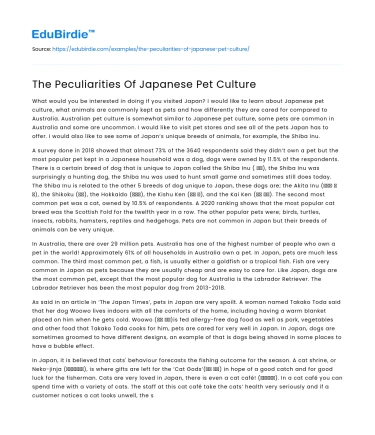What would you be interested in doing if you visited Japan? I would like to learn about Japanese pet culture, what animals are commonly kept as pets and how differently they are cared for compared to Australia. Australian pet culture is somewhat similar to Japanese pet culture, some pets are common in Australia and some are uncommon. I would like to visit pet stores and see all of the pets Japan has to offer. I would also like to see some of Japan’s unique breeds of animals, for example, the Shiba Inu.
A survey done in 2018 showed that almost 73% of the 3640 respondents said they didn’t own a pet but the most popular pet kept in a Japanese household was a dog, dogs were owned by 11.5% of the respondents. There is a certain breed of dog that is unique to Japan called the Shiba Inu ( 柴犬), the Shiba Inu was surprisingly a hunting dog, the Shiba Inu was used to hunt small game and sometimes still does today. The Shiba Inu is related to the other 5 breeds of dog unique to Japan, these dogs are; the Akita Inu (あきた いぬ), the Shikoku (四国), the Hokkaido (北海道), the Kishu Ken (機種 券), and the Kai Ken (かい けん). The second most common pet was a cat, owned by 10.5% of respondents. A 2020 ranking shows that the most popular cat breed was the Scottish Fold for the twelfth year in a row. The other popular pets were; birds, turtles, insects, rabbits, hamsters, reptiles and hedgehogs. Pets are not common in Japan but their breeds of animals can be very unique.
Save your time!
We can take care of your essay
- Proper editing and formatting
- Free revision, title page, and bibliography
- Flexible prices and money-back guarantee
In Australia, there are over 29 million pets. Australia has one of the highest number of people who own a pet in the world! Approximately 61% of all households in Australia own a pet. In Japan, pets are much less common. The third most common pet, a fish, is usually either a goldfish or a tropical fish. Fish are very common in Japan as pets because they are usually cheap and are easy to care for. Like Japan, dogs are the most common pet, except that the most popular dog for Australia is the Labrador Retriever. The Labrador Retriever has been the most popular dog from 2013-2018.
As said in an article in ‘The Japan Times’, pets in Japan are very spoilt. A woman named Takako Toda said that her dog Woowo lives indoors with all the comforts of the home, including having a warm blanket placed on him when he gets cold. Woowo (ウー ウォ)is fed allergy-free dog food as well as pork, vegetables and other food that Takako Toda cooks for him, pets are cared for very well in Japan. In Japan, dogs are sometimes groomed to have different designs, an example of that is dogs being shaved in some places to have a bubble effect.
In Japan, it is believed that cats' behaviour forecasts the fishing outcome for the season. A cat shrine, or Neko-jinja (ネコジンジャ), is where gifts are left for the ‘Cat Gods’(猫の 神々) in hope of a good catch and for good luck for the fisherman. Cats are very loved in Japan, there is even a cat café! (猫コーヒー). In a cat café you can spend time with a variety of cats. The staff at this cat café take the cats’ health very seriously and if a customer notices a cat looks unwell, the staff get the cat medical attention immediately. You can even purchase food for the cats from the café for them to eat (the food is safe for them to eat and is not toxic to them). If I were to go to Japan I would definitely visit a cat café!
In conclusion, I would like to visit Japan to learn more about their pets and compare that to Australia’s pets, even though they may be slightly similar. I would learn about how the Japanese people worship the ‘Cat Gods’ and the history of the shrines. I would like to see how different pets live, what their usual diet consists of and their everyday routines. Finally, I would like to see the cats in Japan that roam on the streets because as the article in Japan Magazine suggests, the cats are very friendly and I believe that going to Japan would be a great opportunity to learn further about Japanese pet culture.






 Stuck on your essay?
Stuck on your essay?

